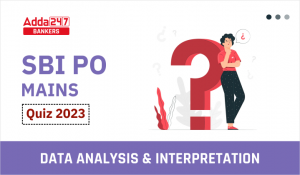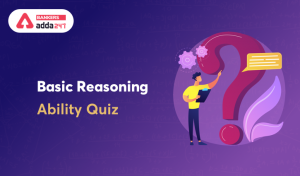(a) inject liquidity
(b) absorb liquidity
(c) increase the liquidity with the banking system
(d) to keep the liquidity at one level
(e) None of the given options is true
S1. Ans.(b)
Sol. Repo operations therefore inject liquidity into the system. Reverse repo operation is when RBI borrows money from banks by lending securities. The interest rate paid by RBI is in this case is called the reverse repo rate. Reverse repo operation therefore absorbs the liquidity in the system.
Q2. The ratio of the Cash Reserves that the banks are required to keep with the RBI is known as-
(a) Liquidity Ratio
(b) SLR
(c) CRR
(d) Net Demand and Time Liability
(e) None of the given options is true
S2. Ans.(c)
Sol. Cash Reserve Ratio (CRR) is the amount of funds that the banks have to keep with the RBI.
Q3. The term ‘Ways and Means’ advances refers to-
(a) the advances allowed under DRI Scheme by commercial banks
(b) the advances allowed by commercial banks under Twenty Point Economic Programme
(c) the temporary advances made to the government by its bankers to bridge the interval between expenditure and the flow of receipts of revenues
(d) All of the above
(e) None of the given options is true
S3. Ans.(d)
Sol. All of the above
Q4. The rate of interest banks charge it main/major and prime customers is popularly called as-
(a) Risk Premium
(b) Prime Lending Rate
(c) Repo Rate
(d) Reverse Repo Rate
(e) Cost of Fund
S4. Ans.(b)
Sol. The interest rate charged by banks to their largest, most secure, and most creditworthy customers on short-term loans. This rate is used as a guide for computing interest rates for other borrowers.
Q5. What is Repo Rate?
(a) It is a rate at which RBI sell government securities to banks
(b) The rate at which banks borrow money from the RBI by selling their surplus government securities to RBI
(c) It is a rate at which RBI allows small loans in the market
(d) It is a rate which is offered by Banks to their most valued customers or prime customers
(e) None of the given options is true
S5. Ans.(b)
Sol. The rate at which banks borrow money from the RBI by selling their surplus government securities to RBI is known as “Repo Rate.
Q6. The term ‘BSR’ refers to-
(a) Bank’s Selling Rate
(b) Basic Statistical Returns
(c) Annual returns submitted by banks to RBI in respect of priority sector advances
(d) Quarterly statement of advances to agriculture
(e) None of the given options is true
S6. Ans.(b)
Sol. Basic Statistical Return (BSR) System. The BSR system was introduced in December 1972 following the recommendation of the Committee on Banking Statistics adapting from the erstwhile data reporting system called Uniform Balance Book (UBB).
Q7. One rupee notes bear the signature of-
(a) Governor of Reserve Bank of India
(b) Prime Minister of India
(c) President of India
(d) Secretary, Ministry of Finance (Government of India)
(e) None of the given options is true
S7. Ans.(d)
Sol. The One Rupee note is issued by Ministry of Finance and it bears the signatures of Finance Secretary, while other notes bear the signature of Governor RBI.
Q8. The note-issue system in India is based on-
(a) Gold Deposit system
(b) Minimum Reserve System
(c) Proportional Reserve System
(d) Simple Deposit System
(e) None of the given options is true
S8. Ans.(b)
Sol. Initially, the proportional reserve system was adopted in India. Later on, India adopted the minimum reserve system and is still continuing with this system of note issue. The entire issue of currency notes is subjected to the regulations framed in the RBI Act, 1935.
Q9. The Indian rupee is a-
(a) token coin
(b) standard-token coin
(c) standard coin
(d) gold coin
(e) None of the given options is true
S9. Ans.(b)
Sol. Indian rupee coin is a mixture of the standard coin and the token coin. Like standard money, Indian rupee is of unlimited tender. Like token money it’s face value exceeds its intrinsic value.
Q10. The currency notes are issued by the Reserve Bank of India under the signature of-
(a) Executive Director
(b) Deputy Governor
(c) Governor
(d) Secretary
(e) None of the given options is true
S10. Ans.(c)
Sol. The currency notes are issued by the Reserve Bank of India under the signature of Governor of RBI.
Q11. Which of the following Institute was established in 1969 by the Reserve Bank of India, in consultation with the Government of India, as an autonomous apex institution for research, training, education and consultancy in bank management?
(a) Bankers Training College, Bombay
(b) College of Agricultural Banking, Pune
(c) NIBM
(d) All of the above
(e) None of the given options is true
S11. Ans.(c)
Sol. National Institute of Bank Management (NIBM) was established in 1969 by the Reserve Bank of India, in consultation with the Government of India, as an autonomous apex institution for research, training, education and consultancy in bank management. Its mandate is to play a proactive role of “think-tank” of the banking system. NIBM is part of the grand vision of giving a new direction to the banking industry in India and making the industry a more cost-effective instrument for national development.
Q12. In periods of depression when the Reserve Bank desires to encourage the banking system to create more credit it-
(a) reduces the bank rate
(b) raises the bank rate
(c) permits the bank rate to be decided by market forces
(d) All of the above
(e) None of the given options is true
S12. Ans.(a)
Sol. When Bank Rate is increased by RBI, the borrowing costs of the banks increase which, in return, reduce the supply of money in the market. Additionally, when the unemployment rate within a country increases, the central bank decreases the bank rate so that individuals can get loan at a reduced rate.
Q13. For the performance of its duties as the regulator of credit, the Reserve Bank of India possesses the usual instruments of general credit control, viz-?
(a) bank rate
(b) open market operation
(c) the power to vary the reserve requirement of banks
(d) All of the above
(e) None of the given options is true
S13. Ans.(d)
Sol. All of the above.
Q14. When the Reserve Bank desires to restrict expansion of credit it-
(a) raises the bank rate
(b) reduces the bank rate
(c) freezes the bank rate
(d) None of the given options is true
(e) All of the above
S14. Ans.(a)
Sol. When Bank Rate is increased by RBI, the borrowing costs of the banks increase which, in return, reduce the supply of money in the market. Additionally, when the unemployment rate within a country increases, the central bank decreases the bank rate so that individuals can get loan at a reduced rate.
Q15. The currency notes issued by RBI have a cent percent cover is-
(a) approved assets
(b) gold
(c) foreign exchange
(d) trustee securities
(e) None of the given options is true
S15. Ans.(a)
Sol. Reserve Bank notes have a cent per cent cover in approved assets. There is no ceiling on the amount of notes that can be issued by the Bank at any time. According to Section 33 of the RBI Act, the assets of the Issue Department against which currency notes are issued have to consist of gold coin and bullion, foreign securities, rupee coin.






 Quantitative Aptitude Quiz For SBI PO Ma...
Quantitative Aptitude Quiz For SBI PO Ma...
 Inequalities Basic Reasoning Quiz for Al...
Inequalities Basic Reasoning Quiz for Al...





